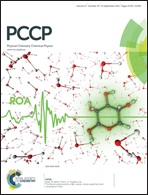Effects of constituent ions of a phosphonium-based ionic liquid on molecular organization of H2O as probed by 1-propanol: tetrabutylphosphonium and trifluoroacetate ions†
Abstract
Aqueous solutions of tetrabutylphosphonium trifluoroacetate, [P4444]CF3COO, exhibit a liquid–liquid phase transition with a lower critical solution temperature. Herein, we characterized the constituent ions, [P4444]+ and CF3COO−, in terms of their effects on the molecular organization of H2O on the basis of 1-propanol probing methodology devised by Koga et al. The resulting characterization of the hydrophobicity/hydrophilicity is displayed on a two-dimensional map together with previous results, for a total of four cations and nine anions of typical ionic liquid (IL) constituents. The results indicate that [P4444]+ is the most significant amphiphile with strong hydrophobic and equally strong hydrophilic contributions among the group of constituent cations of ILs studied so far. The hydration number for [P4444]+ was evaluated to be nH = 72, which is three times larger than that of a typical imidazolium-based cation, [C4mim]+. Self-aggregation of [P4444]+ was found to occur in an aqueous solution of [P4444]CF3COO above 0.0080 mole fraction of the IL.


 Please wait while we load your content...
Please wait while we load your content...